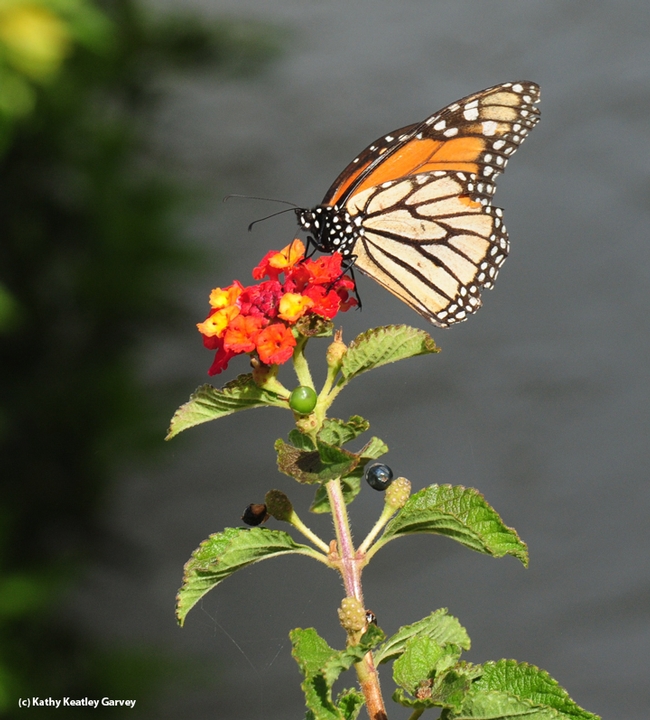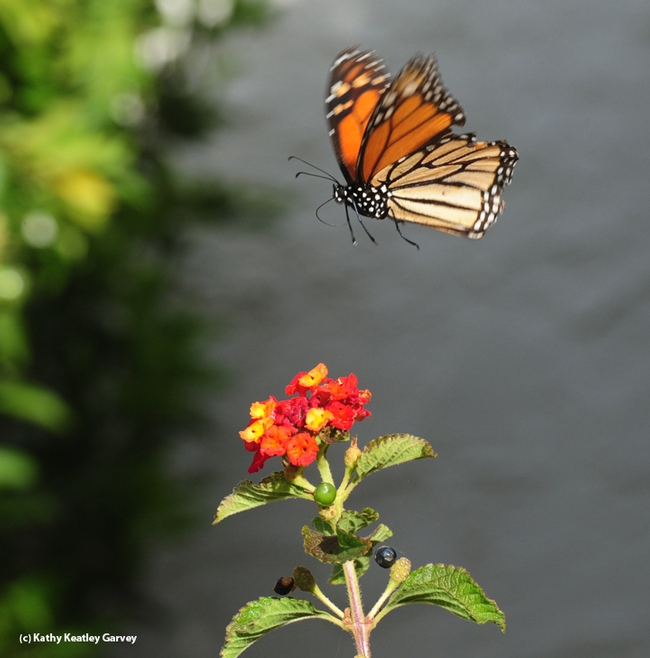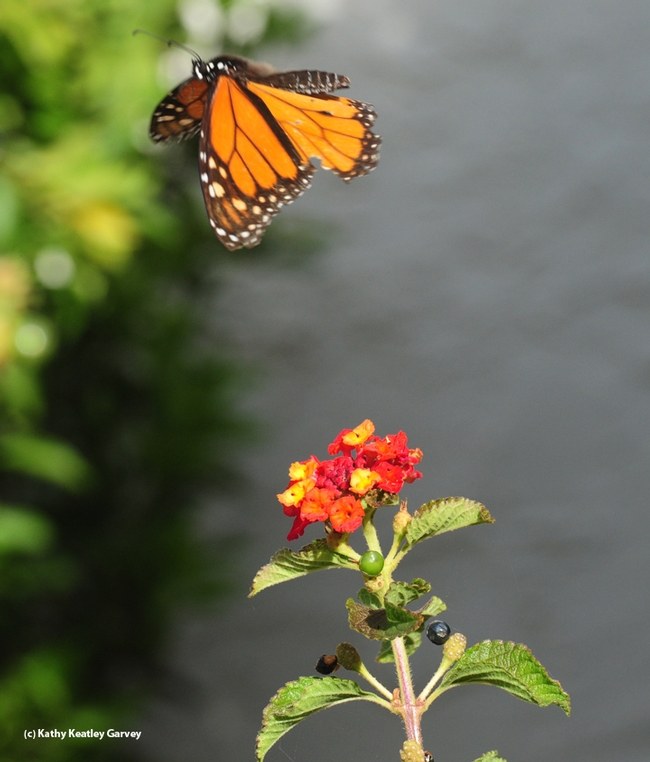- Author: Kathy Keatley Garvey
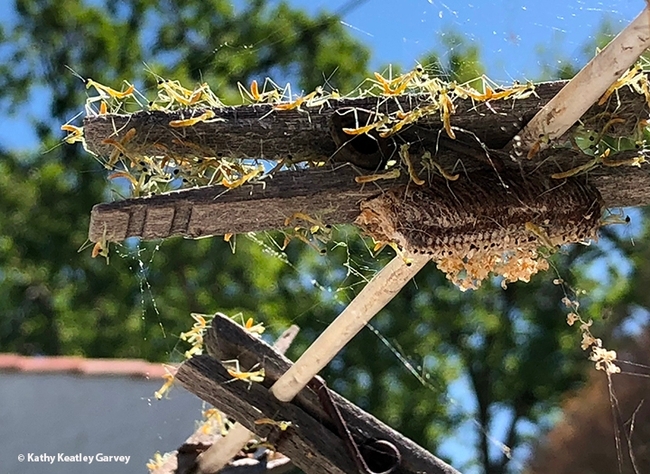
Last fall, a Stagmomantis limbata deposited her egg case, or ootheca, on a clothespin on our outdoor clothesline. On April 9, the clothespin sprang to life. Hundreds of nymphs emerged, scrambled away, and vanished.
Some wandered around on the clothesline. Some ate one another. Some survived to adulthood.
We saw only four in our pollinator garden: a female in the patch of lion's tail, Leonotis leonurus; a female on the Mexican sunflower Tithonia rotundifola; and a male and female in the African blue basil, Ocimum kilimandscharicum × basilicum 'Dark Opal."
They appeared, disappeared, and never re-appeared.
Meanwhile, our lantana, Lantana camara, proved to be a magnet for such pollinators as honey bees, syrphid flies, skippers and cabbage white butterflies, but nary a praying mantis.
Fast forward to the late afternoon of Sept. 25. There perched in the flood of red and gold blossoms was a gush of green, a beautiful gravid praying mantis, S. limbata, looking as if she'd never missed a meal and looking quite Mama-like.
How did we ever miss her?
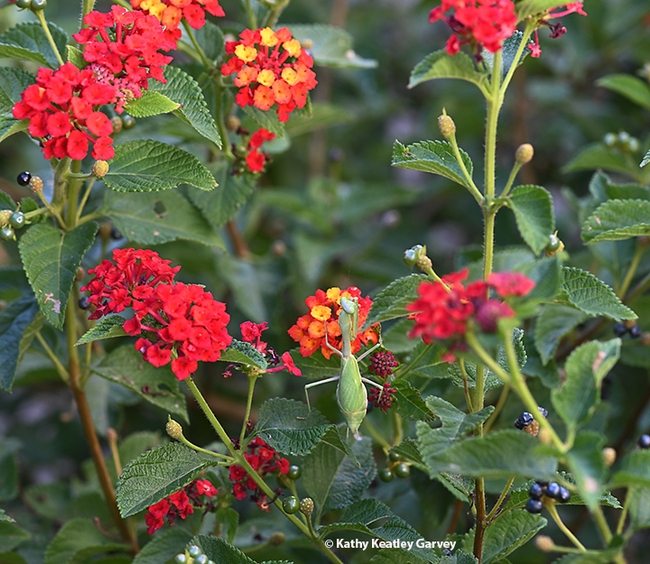
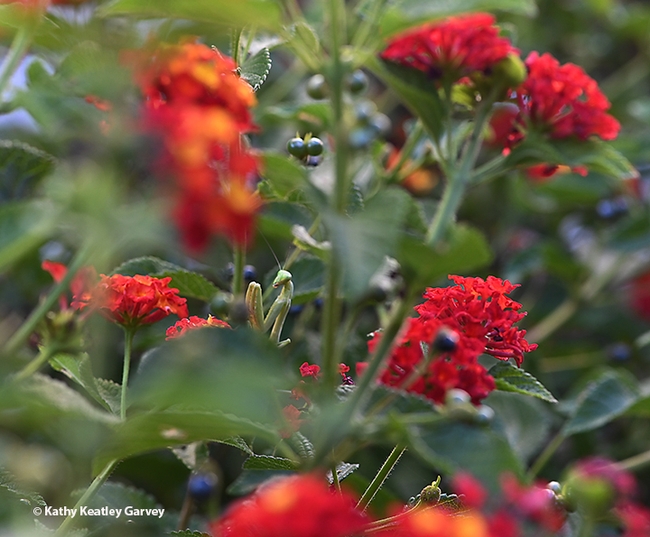
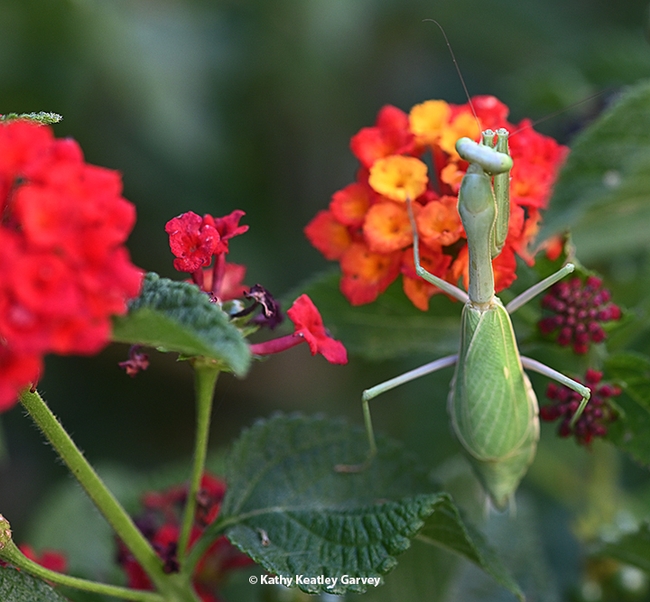
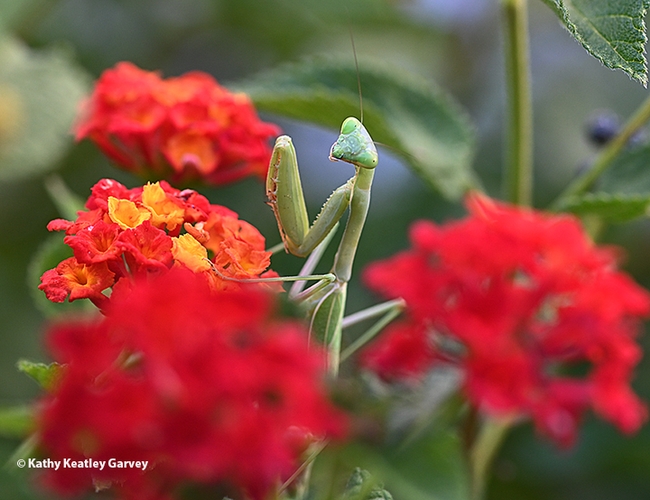
- Author: Kathy Keatley Garvey
Where are you, Gulf Fritillaries?
The Gulf Fritillary (Agraulis vanillae) population seems to be diminishing this year around Solano and Yolo counties.
A few here, a few there, but not in the large numbers of last year.
Last summer the Gulf Frits overwhelmed our passionflower vine (Passiflora), their host plant, and skeletonized it.
Which is what we want them to do. We plant Passiflora for them, not for the fruit or the blossoms. On a good year, they eat it all--blossoms, fruit, leaves and stems--and look for more.
The history of the butterfly in California is as striking as its silver-spangled, reddish-orange coloring.
“It first appeared in California in the vicinity of San Diego in the 1870s,” says noted butterfly expert Art Shapiro, distinguished professor of evolution and ecology at the University of California, Davis. “It spread through Southern California in urban settings and was first recorded in the Bay Area about 1908. It became a persistent breeding resident in the East and South Bay in the 1950s and has been there since.”
Shapiro, who has monitored butterflies in central California since 1972 and maintains a research website at http://butterfly.ucdavis.edu, says the Gulf Frit “apparently bred in the Sacramento area and possibly in Davis in the 1960s, becoming extinct in the early 1970s, then recolonizing again throughout the area since 2000.”
It's making a comeback, but this year it doesn't seem to be "coming back" so much.
Want to attract the Gulf Frit? Plant its host plant and some of its favorite nectar plants. In our pollinator garden in Vacaville, their favorite nectar sources include the butterfly bush (Buddleia), Mexican sunflower (Tithonia) and lantana (genus Lantana.)
Plant them and they will come--if they're around!
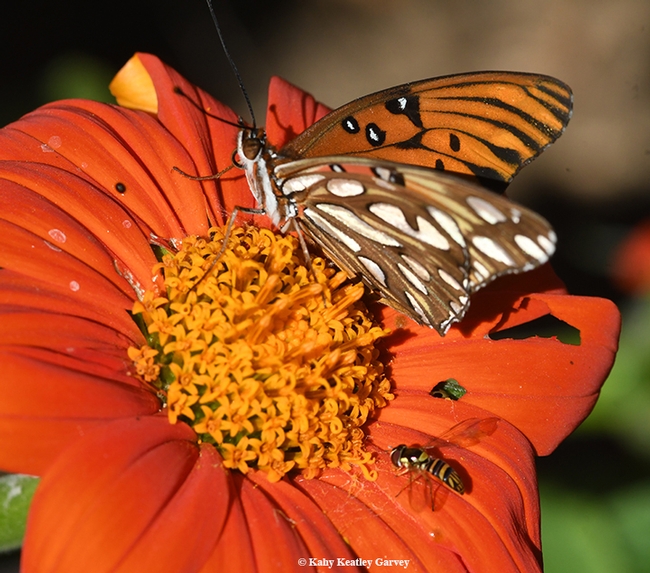
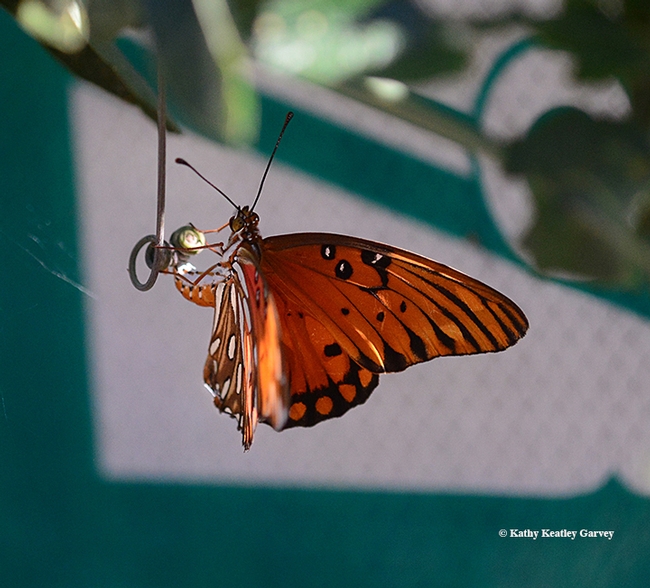
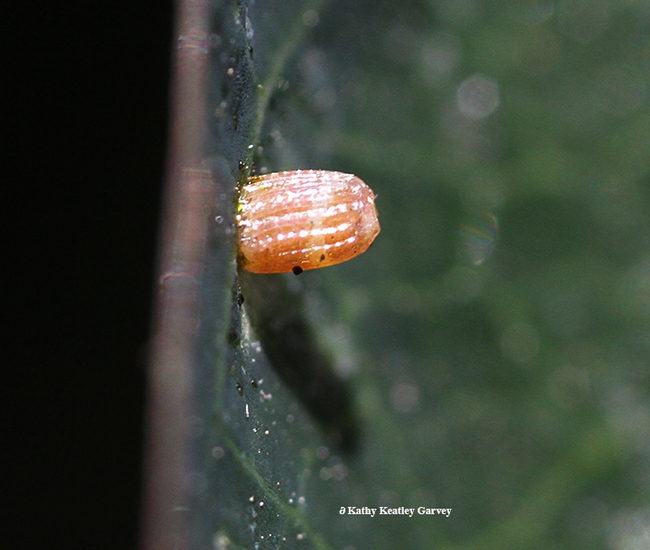
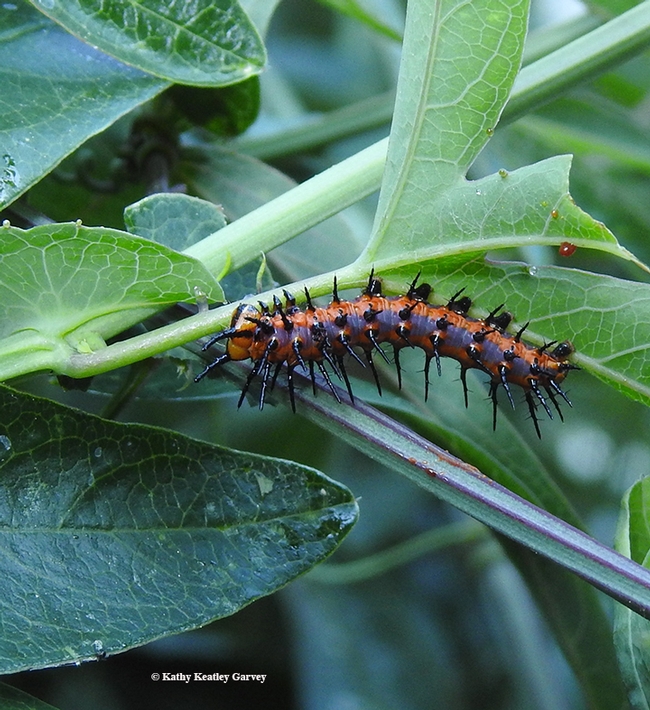
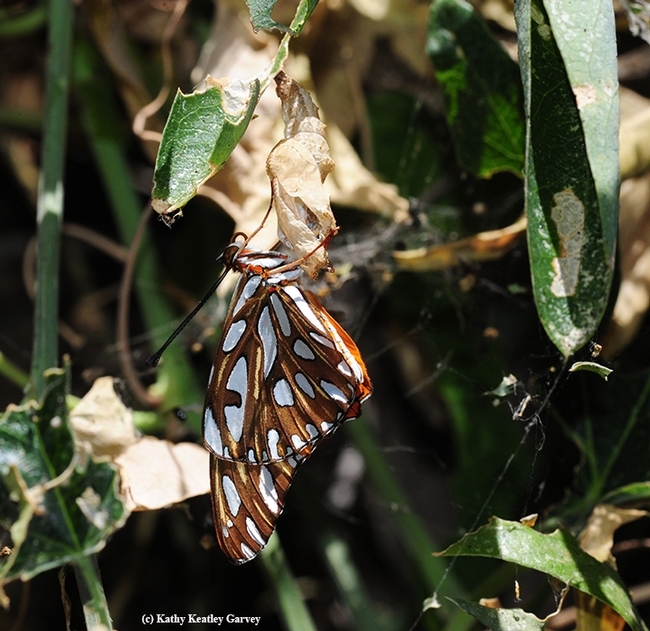
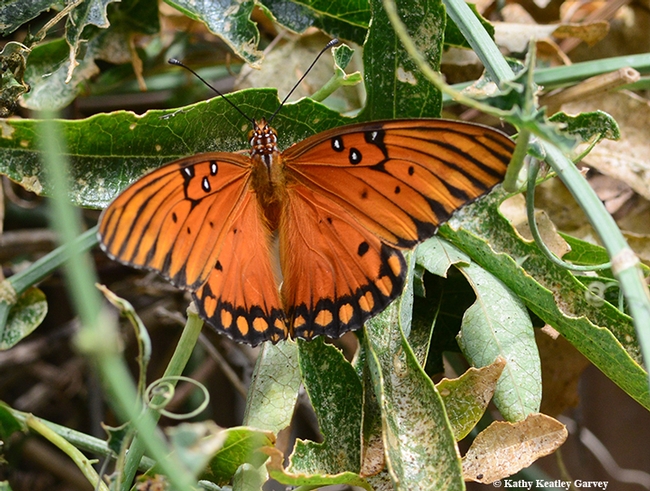
- Author: Kathy Keatley Garvey
They're everywhere.
But they're not welcome.
Agriculturists who commercially grow cabbage and other cucurbits aren't fond of the cabbage white butterlfy, Pieris rapae, because its larvae are pests that ravish their crops.
No welcome mat for them.
This butterfly, however, is welcome--sort of--starting Jan. 1 of every year in the three-county area of Sacramento, Solano and Yolo. It's the target of the "Beer for a Butterfly Contest," sponsored by Art Shapiro, UC Davis distinguished professor of evolution and ecology. The first one collected in the three-county area collects a pitcher of beer or its equivalent.
Professor Shapiro, who maintains a research website at http://butterfly.ucdavis.edu, launched the contest in 1972 as part of his long-term studies of butterfly life cycles and climate change. Pieris rapae is emerging earlier and earlier as the regional climate has warmed, he says. "The cabbage white is now emerging a week or so earlier on average than it did 30 years ago here."
He usually wins the suds-for-a-bug contest; he has been defeated only four times, and all by UC Davis graduate students. This year (2018) he collected the cabbage white butterfly, Pieris rapae, at 11:23 a.m. Friday, Jan. 19 in one of his frequented sites—a mustard patch by railroad tracks in West Sacramento, Yolo County. (See Bug Squad blog)
Last weekend we spotted a cabbage white nectaring on lantana, a common occurrence. What was not so common was that this one wasn't skittish. It lingered like a ballerina anticipating a curtain call, and allowed us to photograph it in flight.
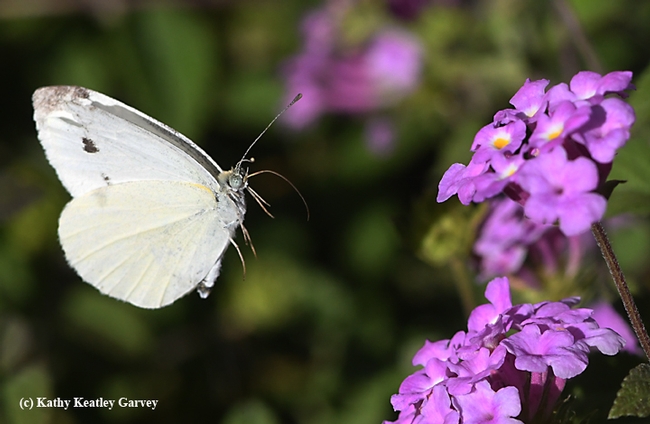
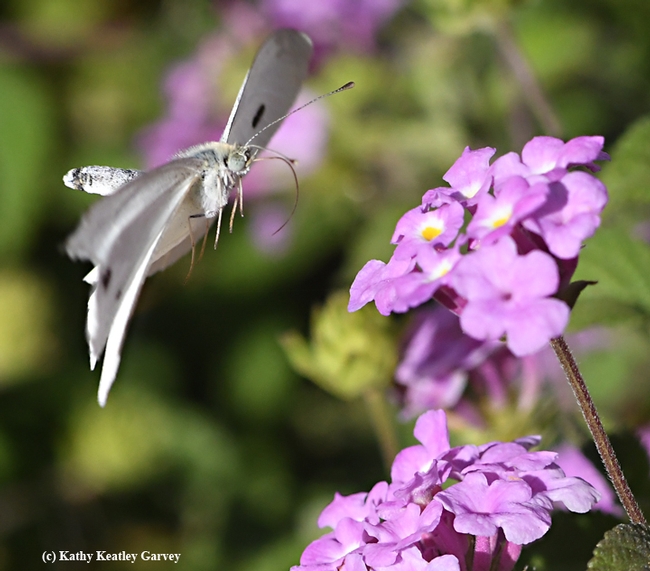
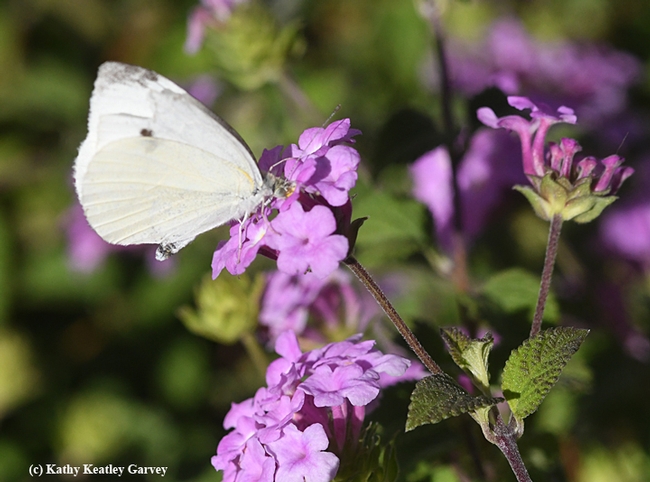
- Author: Kathy Keatley Garvey
Strange thing, nobody ever says "as green as a green bottle fly."
'Cept maybe an entomologist.
You've heard:
- As green as an emerald
- As green as a lizard
- As green as a gourd
- As green as grass
- As green as bottled glass
- As green as it gets
But as "green as a bottle fly" (or blow fly in the family Calliphoridae)?
No. Most people cringe at the very sound. They associate green bottle flies with their larvae, aka maggots, which eat rotting flesh. These insects lay their eggs in cadaver tissue. At crime scenes, forensic entomologists can determine the time of death by examining the developmental stage of the larvae.
And, of course, maggots are used medically in maggot therapy (to consume dead tissue around live tissue).
Then there's Maggot Art, coined by a former UC Davis entomology major, Rebecca O'Flaherty. At the annual UC Davis Picnic Day, children visiting Briggs Hall (home of the UC Davis Department of Entomology and Nematology) engage in Maggot Art, picking up a maggot with forceps, dipping it into non-toxic, water-based paint, and then letting it crawl on a white sheet of paper! Voila! Maggot Art, suitable for framing! (See Bug Squad, "Me and My Maggot." Some of the young artists get quite attached to the maggots and ask their parents if they can take them home. Of course, the answer is "Yes!" (Not!) Want to try Maggot Art? Mark your calendar for April 22, 2017 when the 103rd annual UC Davis Picnic Day takes place.
Green bottle flies can also be beautiful. Have you ever seen an emerald green bottle fly sipping nectar from a red flower, such as Lantana? When the light is just right, this little insect can make you say "Wow!"
Plus, it's a pollinator. It gets a little recognition, but not much, during National Pollinator Week.
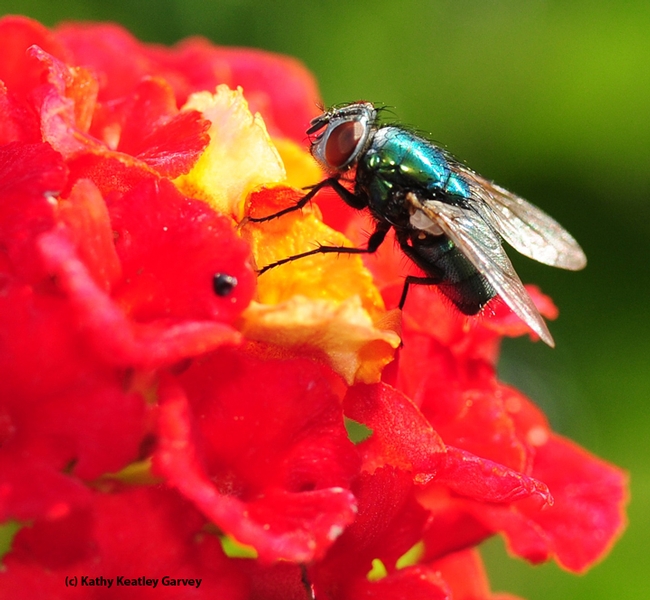
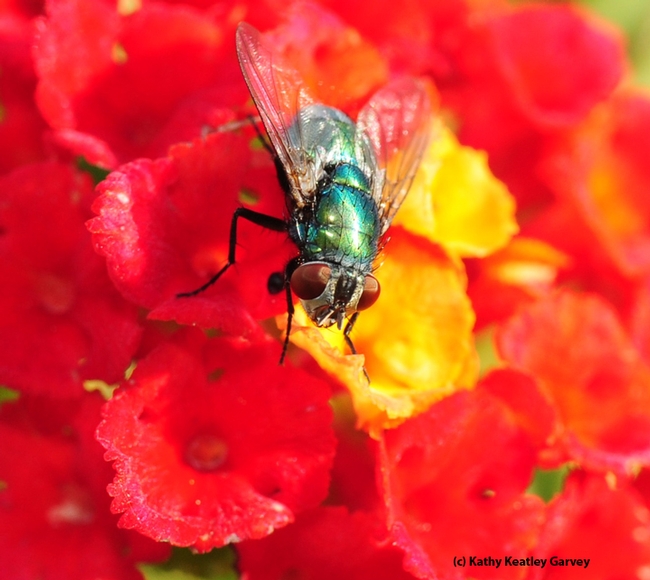
- Author: Kathy Keatley Garvey
What amazing journeys!
For the last two months, migratory monarch butterflies have regularly stopped for flight fuel in our 600-square-foot pollinator garden in Vacaville, Calif. to nectar on Mexican sunflower (Tithonia), butterfly bush (Buddleia) and Lantana.
At any given time--morning and afternoon throughout September and October--we'd see four and five in the garden. A veritable migratory corridor! A veritable visual feast!
Now it's November, and we haven't seen any for a week. They've probably already reached their destination--overwintering sites in the area, including Santa Cruz and Pacific Grove.
On Labor Day, we photographed a tagged one, part of the research project of David James, entomologist at Washington State University. (See Bug Squad blog; WSU News story by Linda Seiford; and a Daily Evergreen piece by reporter Haley Donwerth on the Vacaville find. ABC, Channel 10, Sacramento, also covered "Why does this butterfly have a sticker on it?", interviewing butterfly expert Art Shapiro, UC Davis distinguished professor of evolution and ecology.
It's exciting to read the reports on the Monarchs in the Pacific Northwest Facebook page, as the tagged monarchs are photographed and recorded. Several recent entries:
- Nov. 7: "Two new tag recoveries from California! Both are currently in the Lighthouse Field, Santa Cruz overwintering colony (currently numbering about 7000) and both were found by John Dayton. The tagged Monarch (shown on the page) has flown at least 750 miles from Redmond, WA where it was reared and released on September 20 by Connie Grandberg. This is the first recovery of a Seattle-area Monarch in our program! There are now 4 PNW-tagged Monarchs residing at Lighthouse Field! We will provide information on the second new recovery once we get all the associated details."
- Nov. 7: Our second new tag recovery from Santa Cruz! This one is remarkable in that it is almost obscured from view among the other butterflies. As luck would have it, the only bit of the tag showing for John Dayton's camera is the bit with the serial number! A6935, is a female, and she was reared in Brookings in southern Oregon by Andrea Christensen and released by her at nearby Redwood Bar along the Chetco River on August 25. Santa Cruz will be Ms A6935's winter home and who knows where she will go next spring? Many thanks to Andrea and John for making this recovery possible!"
- Nov. 2: "Today we proudly announce the 9th long distance tagged Monarch recovery of this season so far! A female Monarch tag B2174 was found on November 1 at Morro Bay State Beach by Regena Orr a biologist with CA State Parks. B2174 was among about 350 clustering Monarchs and has travelled an estimated 792 miles since September 8 when it was released in Yakima, Washington! This Monarch was reared by Cindy Dunbar as part of a rearing program between PNW Monarchs and Cowiche Canyon Conservancy. 152 monarchs were reared by the 14 members of this group in 2016 and this is the first recovery for the group Congratulations! This Monarch now holds the record of the longest distance traveled by a Yakima-released Monarch. The photo shows a silhouetted group of Monarchs at Morro Bay in 2015."
Stay tuned. And stay focused with your camera! You might see a tagged one at an overwintering site.
